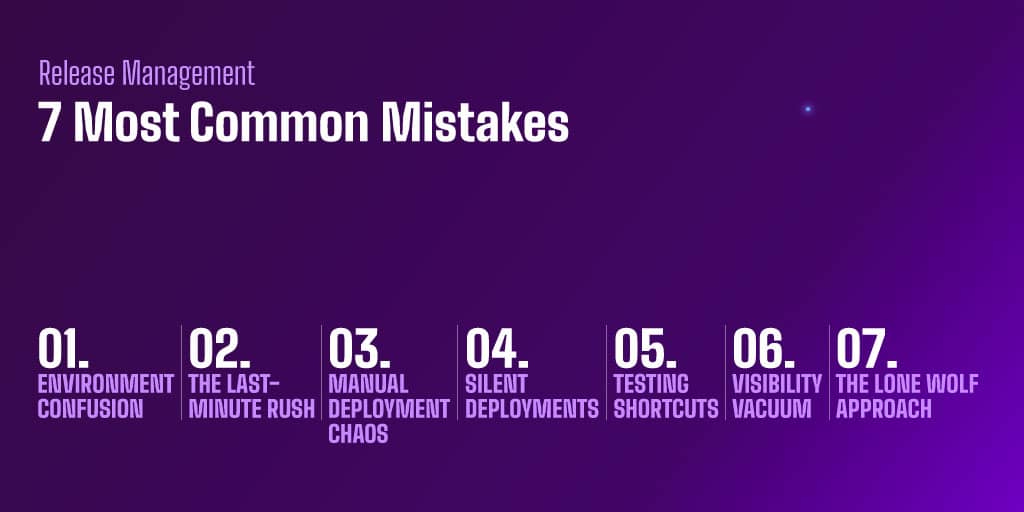Key Highlights
- Understand the real impact of release management mistakes through firsthand experience.
- Learn how to overcome common pitfalls in software releases.
- Discover practical solutions to improve deployment stability and team collaboration.
"The table does not exist." Those dreaded words still haunt me after 15 years as a software developer and manager. A catastrophic incident from my internship days serves as a stark reminder of the dangers lurking in software releases. Fresh-faced and overconfident, I was tasked with updating a test correction system, eager to showcase my database optimization skills. That eagerness would soon turn into a valuable lesson.
I only overlooked a "tiny" detail: the production database environment was incorrectly configured to allow modifications from my user account. I hadn't fully grasped the distinction between development and production environments. Acting hastily, I executed a development script directly on the production database, causing all tables to be deleted and the system to crash completely. Dozens of test correction operators were instantly cut off from their work, and panic ensued.
I quickly restored the database from a recent backup, salvaging the situation. The gravity of my mistake, however, was not lost on me. I had learned a harsh lesson about how software releases can profoundly impact real-world users. This experience became a catalyst for change, driving me to refine my processes, practices, and tools for software releases.

The 7 Critical Release Management Mistakes (And How to Learn from Them)
Let's explore each common pitfall I encountered, along with practical solutions and actionable steps you can implement today:
1. Environment Confusion: The Production Disaster
When I accidentally ran development scripts in production due to unclear environment boundaries, it became clear that strict environment segregation and access controls were essential. We established clear environment documentation with access matrices, implemented different color schemes for different environments, and set up role-based access control with dedicated administrator roles.
2. The Last-Minute Rush
An untested database script added at the last moment led to system failure, teaching us the importance of proper deployment safeguards. We implemented automated rollback scripts, health checks with automatic rollbacks, and comprehensive recovery procedures for each deployment.
3. Manual Deployment Chaos
After experiencing numerous human errors from manual deployments, we switched to Infrastructure as Code and automated deployments. We started with simple deployment scripts, then gradually adopted tools like Terraform, Ansible or Pulumi and set up CI/CD pipelines.
4. Silent Deployments
Communication gaps caused unnecessary panic among team members and users. We established a standardized release process with a comprehensive release checklist (you can find our template there), implemented a centralized dashboard for real-time updates, created communication templates, set up automated notifications, and scheduled regular stakeholder meetings.
Learn how Release Dashboards will help you master your communication.
Learn how Release Dashboards will help you master your communication.
5. Testing Shortcuts
Inadequate testing repeatedly led to production issues until we implemented a comprehensive testing strategy. This included automated regression testing, integration testing, and performance monitoring. We created automated test suites, set up production-like staging environments, and implemented post-deployment smoke tests.
6. Visibility Vacuum
Poor visibility into the release process was resolved by implementing robust monitoring and tracking tools. We set up comprehensive dashboards in Jira thanks to the Golive App, defined key success metrics, and implemented thorough error tracking and alerting systems.
7. The Lone Wolf Approach
Working in isolation led to preventable mistakes, prompting us to create a collaborative release culture. We established peer review processes, regular knowledge sharing sessions, and release retrospectives. We also improved team coordination using tools like Jira - following Atlassian’s best practices.
Remember that following proven best practices and methodologies makes software releases more successful. For a comprehensive guide on release management best practices and additional insights, check out this essential guide to software release management. Start with small changes, implement improvements gradually, and continuously refine your process based on team feedback and results.
Conclusion:
Acknowledging mistakes and transforming my approach helped prevent future disasters while elevating my software release practices. I encourage you to follow this path. Foster a culture of continuous learning, establish robust procedures, and harness modern technology. Together, these steps will help ensure consistent, successful software deployments.
Key Takeaways
- Implement strict environment controls and automated deployment pipelines
- Establish comprehensive testing protocols and monitoring systems
- Create clear communication channels and documentation standards
- Foster a collaborative release culture with peer reviews
- Set up robust rollback procedures and recovery mechanisms
Bonus
If you are coming from our LinkedIn post, here is the answer key for the spot-the-difference game:
I hope you enjoyed it 😉

Transform your Test Environment Management with Apwide Golive:
Leading companies have already Golive as part of their DevOps toolchain:





Free trial / Free forever up to 10 Jira Cloud users!


My brother recommended I may like this website. He used
to be entirely right. This publish actually made
my day. You cann’t imagine just how so much time I had spent for this info!
Thank you!